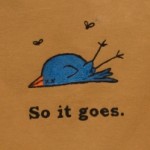Pattern transfer to preserve larger sizes…..
-
12 years ago LINK
 cybele727
@cybele727
cybele727
@cybele727
Hi everyone,
I would like some advice. Also if any of you have a blog entry, PLEASE, PLEASE PLEASE feel free to post a link to it.
Miss SassyPants is a 3T. How do you preserve the larger sizes? When I learned to sew, we cut them out b/c you were “ideally” (laughable) the same size forever, so you didn’t care about the other sizes. However, with children’s patterns, we do care!
How do you all handle this? (i.e. preserve the larger sizes for the future). I especially will need this as Miss SassyPants will be going into the next pattern size in a year or so, depending on which pattern it is.
What I have been doing is a rough cut around the largest size and pinning, and using tracing paper. It is just so tedious. Bleh. But maybe pinning and cutting will always be tedious and not the sexy work of revving up the machine! 🙂
Thanks in advance.
Jenny
12 years ago LINK Tamara
@justsewit
Tamara
@justsewit
I was taught to cut at the largest size when cutting the pattern and then fold the excess in but most of the ladies trace off the size they need and use the interfacing/ tracing paper version as their pattern while they need it. This way the pattern itself stays intact. It is also a great way to do this if you need to make alterations.
12 years ago LINK mle bb
@mle bb
mle bb
@mle bb
Jenny, I trace all my patterns onto freezer paper using a ball point pen. Yes, I know it is still tracing, BUT, once you have it traced onto the freezer paper you can use it MANY TIMES (so far I have gone up to 30 uses for a single piece) AND I like using freezer paper cause I can iron it onto the fabric and not use any pins to cut out the pattern! I feel so great once I have a whole pattern traced and then I stash them all away in a plastic paper protector and keep ’em in a binder. the sexy revving of the machine always has to wait for the busy work to be done! I hope my method gives you some ideas 🙂
Emily
12 years ago LINKwith love Heidi @with love Heidi
I have recently begun to use lightweight interfacting for tracing/making patterns. This stuff is great you can see through it, it irons and I presume it holds up well. I tend to do a big batch of tracing. I have folders with plastic sleeves in them, one for each pattern, each sleeve is labeled with the patten and size and all the size pieces for that pattern go in there. I love going to make a pattern and finding that the size I need is already traced off. I sometines spend half a day or so just tracing off all the pieces for all the sizes of one pattern. A 12 day stint in hospital last year allowed me to trace off every pattern in every size from LTTS. Very handy (not the 12 days in hospital!).
12 years ago LINK Jane
@jesims
Jane
@jesims
I trace my patterns onto Pellon Tru-Grid. It is washable and maneuvers like fabric. It can also be ironed, so I can fold the pieces and put them in an envelope. When I want to use them again, just iron and it’s good as new. The Tru-Grid isn’t slippery and adheres to the fabric a little so I don’t use as many pins either. (Side note:you can get a 10 yard bolt from Overstock.com for around $20). Also because of the 1″ grid on the Tru-Grid it makes lengthening a pattern very easy.
Jane
12 years ago LINK Lightning McStitch
@LightningMcStitch
Lightning McStitch
@LightningMcStitch
I also trace onto the lightweight interfacing. Spotlight recently had it on sale at fifty cents a metre. I stocked up on a ten metre roll! Heidi I know it’s wrong, but I’m almost jealous of that hospital stay.
I finally got organised and stopped stuffing the traced patterns back in the packets, and now have nicely labelled clear plastic sleeves in folders too.
I don’t really mind pattern tracing. I’ve got a few old bike racing trophies that make perfect paperweights, and I’ll confess that I even trace the lettering and numbering off the pattern piece (nerd alert!)
12 years ago LINK Jane
@jesims
Jane
@jesims
LM,
A kindred nerd, I trace the numbers and lettering too!
Jane
12 years ago LINKRobin @Robin
I think I’m one of the last people in the world to have taken cartography the old fashioned way (when we traced maps onto onion skin and added information to them rather than create computer maps). I trace patterns onto freezer paper. I have my favorite Staedler pencil, use a ruler, and a tiny bit of masking tape to hold it all together. Get a great pencil, makes all the difference.
12 years ago LINKwith love Heidi @with love Heidi
Lightning, I also trace all number, wording or letters and if I make changes I also write the changes on the pattern! I was sewing with a young friend and after watching me draft 4 different sized wings or the badminton skirts she asks “Do you always label your sewing patterns?”. The 50c a meter would have been nice! I’ve been thinking of buying a whole roll, but now I’m not sewing HP costumes I’m not sure how fast I’ll go through it. The biking trophies sound much more exciting than my tins of tomatoes soup, tuna etc that I pull out of the cupboards!
On pencils, I like to use the disposable mechanical ones as they never need sharpening and always give a great but fineish line.
12 years ago LINKjoslyn @joslyn
I use a material called Red Dot, sort of like a medium weight interfacing with red dots spaced in an inch grid, to trace all my patterns. I label them and then store them in ziplock bags – one bag per size and outfit. It makes it very easy to find again. The red dot is easy to iron and it keeps its shape and can be used over and over again.
Good luck!
12 years ago LINK cybele727
@cybele727
cybele727
@cybele727
Thank you for bumping those other threads. Now I have research to do! 🙂
12 years ago LINK meleliza
@meleliza
meleliza
@meleliza
I buy tracing paper by the roll at the art supply store. It’s sturdy enough to make alterations and sheer. I trace it with a fine point sharpie and make alterations in colored pencils, maybe different colors for each fitting when it’s complicated. Then I make a note of the final fitting color. For my things, I only trace the pieces I need to alter and work with pattern tissue for the rest. I use the waxed transfer paper to mark fabric most of the time, because it really is very accurate and fairly easy. I use a quilting ruler for whatever straight edges there are and for darts. In that case, i only cut the pattern roughly because ill be tracing it onto the fabric. Sometimes I do cut the tissue as I mostly wear one size (shoulders dont change much) or just make adjustments next time. For kids stuff, if I really only plan to make it once and it was a cheap pattern, I might just cut the tissue. For Oliver and S patterns, I always trace because I know I’ll need another size later. Also, there’s something about cutting into such a pretty and expensive pattern that I just can’t bring myself to do. I don’t keep all the tracings. How many size 2T of one pattern am I going to make?
12 years ago LINK cybele727
@cybele727
cybele727
@cybele727
I purchased a case of medical exam table paper. 21″ (42cm) by 75 yds/m.+-
While I only needed one roll, the cost for 12 was only double the cost for one. ( I already sold 5 rolls for cheap just to make up cost- to sewists and moms of crafty kids. Probably will give a roll to my son’s teacher.)
Now I need to get the waxy paper and a double wheel, as I do have some non seam allowance patterns!
12 years ago LINKbren5kids @bren5kids
I’m too lazy to trace. I use our copyfax machine to make copies of the smaller peices, I usually don’t have to tape together more than two pages. The only thing I trace is large peices like a skirt, and only if it’s shaped or has curves and angles. If its a rectangle I use my cutting mat and ruler and cut the proper dimensions.
12 years ago LINKKim @kmac0107
I know this topic has been discussed in great depth, but when I trace a pattern my lines are not exact. They are within the line underneath just not as accurate as the actual pattern. Does that matter? Corners are hard, do you use a plastic curved ruler for those or just free hand? I just read to tape together a digital pattern then trace it for different sizes rather that printing another copy of the pattern for each size.That sounds like a good idea.
You must be logged in to reply to this topic.
copyright
Unless otherwise credited, all work on this blog is © Liesl + Co., Inc, 2008-2025. You are welcome to link to this blog, but please ask permission before using any text or images.